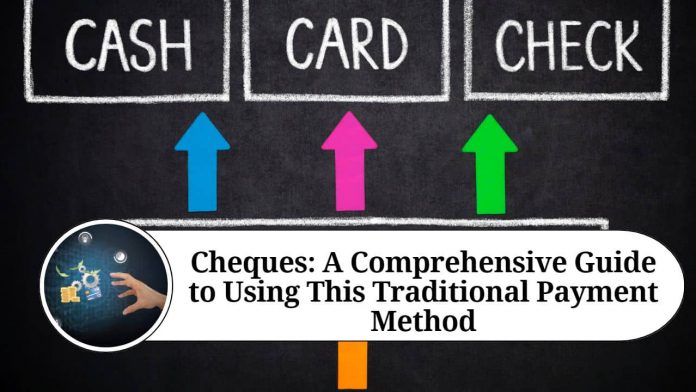INTRODUCTION
A cheque, also spelled as a check, is a document used to transfer money from one bank account to another. It is a form of payment that has been used for centuries, and despite the rise of digital payments, cheques are still commonly used in many parts of the world.
To write a cheque, you will need to have a checking account with a bank or credit union. The account must have sufficient funds to cover the amount of the cheque. The process of writing a cheque involves filling in the date, payee name, amount in words, amount in numbers, and signature.
The first step is to write the date in the top right-hand corner of the cheque. This is important because it helps the payee know when the cheque was written. It’s also important to make sure the date is accurate because cheques have a limited validity period.
The next step is to write the payee’s name on the line that says “Pay to the order of.” This can be a person or a company. It’s important to make sure the name is spelled correctly to avoid any confusion.
After writing the payee’s name, you need to write the amount of the cheque in words on the line below the payee’s name. This is important because it prevents anyone from altering the amount of the cheque. It’s also a good idea to start writing the amount as close to the left-hand side of the line as possible, so there is no space for anyone to add any extra digits.
Once you’ve written the amount in words, you need to write the same amount in numbers in the box provided. This is important because it helps the bank process the cheque faster and accurately.
Finally, you need to sign the cheque in the bottom right-hand corner. This is important because it confirms that you authorize the payment and have sufficient funds to cover the amount.
After you have filled in all the details, you can tear the cheque out of the chequebook and give it to the payee. The payee can then deposit the cheque into their bank account and receive the funds.
Cheques have been around for a long time and continue to be an important method of payment, especially for larger transactions. They offer a secure and convenient way to transfer funds between bank accounts. However, with the rise of digital payments, the use of cheques is slowly declining. Many banks now offer online cheque deposits, which means you can deposit a cheque without having to visit a bank branch.
Cheques are governed by specific rules and regulations to ensure their validity and security. For example, a cheque must be written in ink, and erasures or corrections should be avoided to prevent any fraudulent activity. Additionally, cheques should not be post-dated, which means writing a future date on the cheque, as this could cause confusion or result in bounced cheques.
One of the advantages of using cheques is that they offer a paper trail of transactions. This makes it easier to keep track of your finances, especially for tax or accounting purposes. Furthermore, cheques can also be stopped or canceled if they are lost, stolen or written incorrectly.
However, there are some disadvantages to using cheques. They can take several days to clear, which means there may be a delay in the recipient receiving the funds. Additionally, there may be fees associated with writing or depositing cheques, which can add up over time. Some businesses may also refuse to accept cheques due to the potential risk of fraud or insufficient funds.
In recent years, there has been a push towards digital payments such as online banking, mobile payments and electronic transfers. These methods offer faster and more convenient transactions, often with lower fees. However, cheques continue to be used for a variety of purposes, including bill payments, rent, and other transactions where a paper trail is required.
conclusion
cheques remain a valuable and reliable method of payment, despite the rise of digital payments. While they may not be as convenient as other methods, they offer a paper trail of transactions and are governed by specific rules and regulations to ensure their validity and security. If you need to write a cheque, be sure to follow the correct procedures to avoid any errors or fraudulent activity.
Other Related Blogs: Section 144B Income Tax Act
Frequently Asked Questions (FAQs)
Q.What is a cheque?
A cheque is a document used to transfer money from one bank account to another. It is a form of payment that has been used for centuries and is still commonly used in many parts of the world.
Q.How do I write a cheque?
To write a cheque, you need to fill in the date, payee name, amount in words, amount in numbers, and signature. Start by writing the date in the top right-hand corner of the cheque and then write the payee’s name on the line that says “Pay to the order of.” Next, write the amount of the cheque in words on the line below the payee’s name and then write the same amount in numbers in the box provided. Finally, sign the cheque in the bottom right-hand corner.
Q.How long does it take for a cheque to clear?
The length of time it takes for a cheque to clear depends on the bank and the amount of the cheque. Generally, it takes between two to five business days for a cheque to clear.
Q.Can I stop payment on a cheque?
Yes, you can stop payment on a cheque if it is lost, stolen, or written incorrectly. Contact your bank as soon as possible to initiate the stop payment process.
Q.Can I post-date a cheque?
It is generally not recommended to post-date a cheque as it can cause confusion or result in bounced cheques. However, if you need to post-date a cheque, make sure the recipient is aware of the date and agrees to it.
Q.Can I use a cheque to pay for online purchases?
Some online retailers may accept cheques as a form of payment, but it is not a common method of payment for online transactions. It’s best to check with the retailer before attempting to pay with a cheque.
Q.Are there any fees associated with using cheques?
Some banks may charge fees for writing or depositing cheques. Be sure to check with your bank to see if there are any fees associated with using cheques.
Q.Can I still use cheques in a digital age?
Yes, cheques continue to be used for a variety of purposes, including bill payments, rent, and other transactions where a paper trail is required. However, with the rise of digital payments, the use of cheques is slowly declining.




















